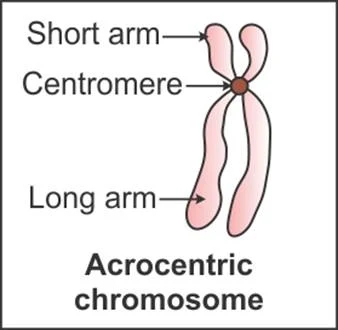Acrocentric Chromosome is a type of chromosome, in which the centromere is located near one of the ends, while one of the chromosome arms is long, the other is short.
Acrocentric Chromosome Diagram with Explanation
An acrocentric chromosome diagram illustrates the structure of acrocentric chromosomes found in many organisms, including humans. Acrocentric chromosomes are characterized by having a centromere located quite close to one end, resulting in one long arm (q) and one very short arm (p).
Key Components are typically shown in an Acrocentric Chromosome Diagram:
- Centromere: The centromere is the point on the chromosome where the two chromatids are joined and is essential for proper chromosome segregation during cell division. In acrocentric chromosomes, the centromere is located near one end, causing the chromosome to have a distinctive asymmetrical shape.
- Short Arm (p): The short arm of the chromosome is designated as "p" (for petite). It is very short and contains specific genetic material crucial for various cellular functions.
- Long Arm (q): The long arm of the chromosome is designated as "q." This arm is longer and typically contains a larger portion of the chromosome's genetic material.
- Satellite: Some acrocentric chromosomes, particularly in humans (e.g., chromosomes 13, 14, 15, 21, and 22), exhibit a visible secondary constriction near the centromere. This region is referred to as the "satellite," and it contains clusters of ribosomal RNA genes.
In an acrocentric chromosome diagram:
- The chromosome is usually depicted as a straight line with a constriction near one end representing the centromere.
- The short arm (p) is illustrated as a tiny segment emanating from the centromere.
- The long arm (q) extends from the other side of the centromere and constitutes the larger portion of the chromosome.
- Any satellites or secondary constrictions (if present) are often represented as small bulges or extensions near the centromeric region.
Image Source: topperlearning.com

